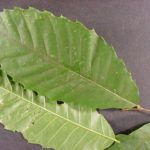American chestnut (Castanea dentata)
Family: Fagaceae
Categories |
Images |
|---|---|
| Form:
This species used to be one of the largest trees in the forest. Now it is only found at heights less than 20 ft. and as stump sprouts. |
|
|
Leaves: Shape: oblong Margin: sharply serrate with bristle teeth Texture: both sides are hairless; dark green above, paler below Variation: parallel |
|
| Bark:
The bark is a dark grayish-brown color and furrowed with broad, flat, scaly ridges. |
|
| Twigs and Buds:
The twigs are lustrous and brown. The buds are long and ovid. |
|
| Flowers and Fruit:
The nuts are flattened on 1 side and found in 2’s and 3’s in each bur. The burs are 2 to 2.5 inches in diameter and are armed with very sharp spines. |
|
| Distinguishing Characteristics:
This species has burr husk covering fruit and alternate, oblong, serrated leaves. Also the tree has dark brown shallowly fissured bark. |
|
| Range:
Formally found from southern Ontario to Maine and south along the Appalachian mountains to Georgia heading west to Mississippi and north to Indiana. |
|
| Silvics:
This species has an intermediate tolerance and occurs on mesic to dry slopes and ridges as well as sandy loams and rocky soils. |
|
| Ecological and Cultural Importance:
The tree was exterminated by chestnut blight, that was also a major blow to wildlife due to loss of consistent mast crops. |

